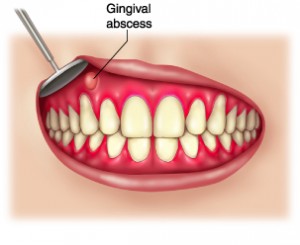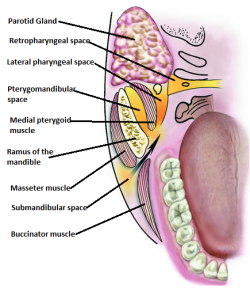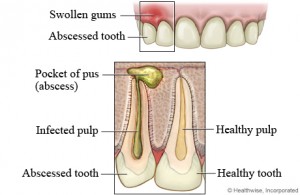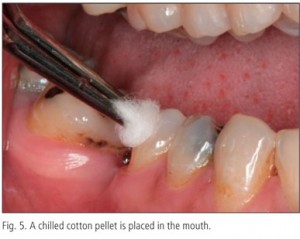Are you refraining yourself from ice cream, cold drinks, cold air in the mornings when you breathe through your mouth causing a jolt to your teeth and forcing you to stay indoors? Even biting on a candy is causingpressure to your tooth? The answer is simple, you are suffering from sensitive teeth. Wondering how did all this happen? It could be due to various reasons from decay to gum disease. Continue reading
Category Archives: Oral Care
How to Cure a Gum Abscess
Having sore gums or a gumboil? Does your tooth hurt upon biting or feels loose? Notice pus oozing out from the gums? You could be suffering from a gum abscess. Continue reading
Hormone induced gingival enlargement
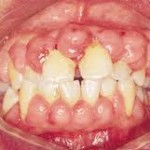 Hormone induced Gingival enlargement
Hormone induced Gingival enlargement
What is gingival enlargement?
Gingival enlargement simply means that there is an increase in the size of your gingival/gums. Continue reading
Symptoms of chronic periodontal disease
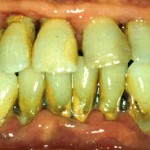 Chronic periodontal disease is a disease which involves the destruction of gums and supporting tissues. This disease is often seen in adults and is the commonest cause of adult tooth loss. Before we proceed to discuss about the symptoms of chronic periodontal diseases, let us have a look at the characteristics of healthy gums. Continue reading
Chronic periodontal disease is a disease which involves the destruction of gums and supporting tissues. This disease is often seen in adults and is the commonest cause of adult tooth loss. Before we proceed to discuss about the symptoms of chronic periodontal diseases, let us have a look at the characteristics of healthy gums. Continue reading
Dangers of an Abscessed Tooth Part 2
Continued from Part 1
- Abscesses in the molar region of either jaw may penetrate the buccal cortical plate above (in the upper jaw) or below (in the lower jaw) the attachments of the buccinators muscle (A muscle that flattens the cheek and retracts the angle of the mouth). In such acute inflammatory edema and pus discharge spread into the soft tissues of the face or neck. This may present as a cellulitis or less frequently as a localized soft tissue abscess depending on the nature of the infection. Such an abscess may track towards the overlying skin to discharge through a sinus on the skin surface. The abscess may then become chronic with the sinus discharging pus periodically, associated with increasing fibrosis, scarring and disfigurement. Continue reading
Dangers of an Abscessed Tooth Part 1
The majority of infections that appears on the mouth and face region are odontogenic or arising in tissues that give origin to the teeth. Of these, approximately 70% present as inflammation around the roots of teeth, principally acute abscess that involves the tooth and bone. Continue reading
Oral Submucous Fibrosis Part 2
COMMON SITES INVOLVED
Buccal mucosa, faucial pillars ,soft palate, lips and hard palate.
The fibrous bands in the buccal mucosa run in a vertical direction ,sometimes so marked that the cheeks are almost immovable.
In the soft palate the fibrous bands radiate from the pterygomandibular raphe or the faucial pillars and have a sear like appearance
Oral Submucous Fibrosis Part 1
DEFINITION
(J.J Pindborg and Sirsat 1966)
It is an insidious chronic disease affecting any part of the oral cavity and sometimes the pharynx. Although occasionally preceded by and /or associated with vesicle formation ,it is always associated with juxta-epithelial inflammatory reaction followed by a fibro-elastic changes of the lamina propria with epithelial atrophy leading to stiffness of the oral mucosa and causing trismus and inability to eat.
First described among five East African women of Indian origin under the term Atrophia idiopathica (tropica) Mucosae Oris by Schwartz 1952
Joshi in 1953 is credited to be the first person who described it and gave the present term “Oral sub-mucous fibrosisâ€.
In the year 1954, Su. 1. P. from Taiwan described similar condition, which he called “Idiopathic Scleroderma of mouth”
What Happens at an Appointment with an Endodontist? Part 2
Continued from Part 1
Cold testing
A cold stimulus such as refrigerant spray is sprayed on a cotton pledget and applied to the tooth under investigation.
Heat testing
A heated source such as a GP stick is applied to the tooth. Continue reading
What Happens at an Appointment with an Endodontist? Part 1
Your dentist referred you to an endodontist for a root canal treatment that he/she finds difficult to do. However you started having the jitters about your endodontic appointment since this is a specialist you are seeking. This article will give you a gist on what happens at an appointment with an endodontist. Continue reading
